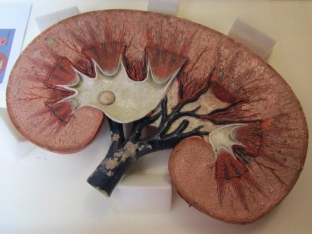It is known that gout is accompanied by a metabolic disorder, against which crystals of uric acid salts are deposited in the joints. It is with gout that nephropathy can develop in 30-50% of cases. The latter causes some forms of kidney damage associated with impaired circulation and excretion of uric acid. Initially, its symptoms may not appear or be, at first glance, not related to the work of the kidneys. However, with the further development of the disease, the symptoms will differ. It is determined by the form of the disease.
What specifically influences the occurrence of gouty nephropathy, and what symptoms will help to identify it?
Why does nephropathy develop with gout? Nephropathy Development Mechanism
Gout has its popular name, which sounds like the "disease of kings", it was believed that it develops due to excessive consumption of alcohol and immoderate food intake. Today, this disease is quite common, especially in men, which is associated with a wrong lifestyle.
However, due to the development of gout, namely, due to a decrease in the level of hypoxanthine-guanine phosphoribosyltransferase in the body, a violation of the process of production and excretion of uric acid, as well as salt deposits, gouty nephropathy may occur. The latter has various manifestations, including the formation of stones and the occurrence of renal colic. In this case, the symptoms of nephropathy differ depending on the type of disease.
What can cause nephropathy in gout?
Metabolic disorders and deposition of uric acid salts in the joints, characteristic of gout, can affect the occurrence of gouty nephropathy. The main factors that cause nephropathy in gout are an increased amount of uric acid produced and a decrease in the ability to excrete it.
It is also worth noting that increased production of uric acid is directly related to the lack of hypoxanthine-guanine phosphoribosyltransferase, which is inherent in early or complex forms of gout. In addition to the above reasons, some factors influence the appearance of gouty nephropathy.
Factors for the development of nephropathy in gout:
- disturbance of the balance of secretion in the tubules of the kidneys and reabsorption of acid salts by them;
- destruction of adenosine triphosphoric acid resulting from chronic alcohol abuse, fructose intolerance, or glycogen disease;
- atherosclerosis of the arteries of the kidneys caused by obesity, as well as an increase in the amount of lipids or phosphates in the blood;
- sour urine.

What are the main symptoms of gouty nephropathy?
Gouty nephropathy may not appear immediately. Only later can the disease make itself felt, but sometimes with absolutely non-specific signs, for example, the appearance of headaches, thirst, and increased fatigue. These symptoms are followed by specific signs inherent in this particular type of ailment. But, depending on the different types, gouty nephropathy will manifest itself in different ways.
There are three forms of gout nephropathy: urate nephrolithiasis, acute uric acid nephropathy, and chronic tubulointerstitial nephritis (chronic TIN). Each of them has its own characteristic symptoms.
Symptoms of urate nephrolithiasis:
- ultrasound detection of urate stones;
- renal colic;
- occurrence of secondary pyelonephritis or other specific changes in the kidneys;
- pain, urinary retention.
Symptoms of acute uric acid nephropathy:
- reduced amount of urine;
- pain in the lumbar region;
- symptoms of poisoning with decay products;
- sometimes increased arthritis, high blood pressure, or renal colic.
Chronic TIN symptoms:
- persistent urination disorder and change in urine structure;
- increased blood pressure;
- in some cases, the appearance of bilateral cysts up to three centimeters in diameter.
It is worth noting that men are more susceptible to the described forms of the disease, since the amount of hypoxanthine-guanine phosphoribosyltransferase is controlled by genes concentrated on the X chromosome. Therefore, when gout is detected, it is worth sticking to a diet and monitoring kidney function by regularly taking a biochemical blood test.







Add a comment